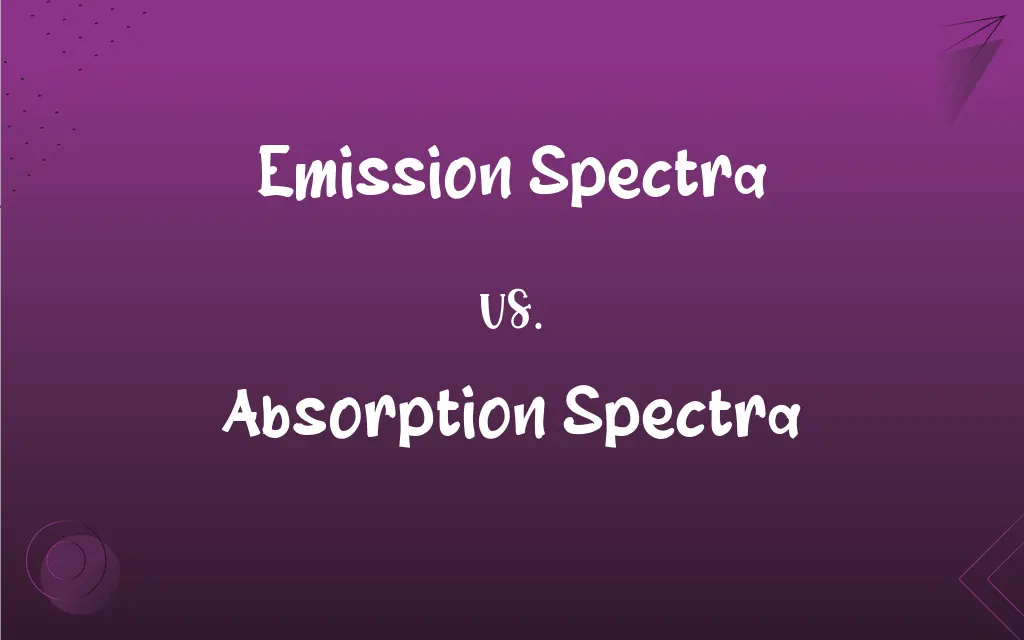Emission Spectra vs. Absorption Spectra: What's the Difference?
Edited by Aimie Carlson || By Harlon Moss || Updated on October 14, 2023
Emission spectra refer to the range of wavelengths emitted by an atom or compound stimulated by energy. Absorption spectra are wavelengths absorbed by a substance, observed as dark lines/regions on a background.

Key Differences
Emission spectra represent the wavelengths of light emitted by an atom or molecule after it has absorbed energy. Absorption Spectra: Conversely, absorption spectra illustrate the wavelengths of light that a substance can absorb.
When observing emission spectra, one typically perceives bright lines or bands on a dark background. In contrast, absorption spectra frequently showcase dark lines or bands superimposed on a bright, continuous spectrum.
Emission spectra provide critical insights into the energy levels within atoms, as the emitted light corresponds to energy differences between electronic energy levels. Meanwhile, absorption spectra lend equivalent insights by revealing the specific energy levels that electrons can occupy, observed through absorbed light.
Scientists employ emission spectra to identify and quantify the elemental composition of distant stars and galaxies. Absorption spectra, on the other hand, are instrumental in studying the concentration of a particular element or compound within a solution, exploiting the correlation between absorbance and concentration.
Emission spectra enable researchers to discern the presence and concentration of elements in unknown samples through quantitative analysis of emitted light. Absorption spectra similarly facilitate the study of chemical substances through discerning the frequencies of light absorbed by the subject material.
ADVERTISEMENT
Comparison Chart
Nature of Spectra
Shows bright lines or bands against a dark background.
Displays dark lines or bands against a bright continuous spectrum.
Generation
Generated by photons emitted from energized atoms or molecules.
Formed when photons are absorbed, exciting electrons to a higher level.
Usage
Utilized to identify elements through emitted light.
Employed to discern elements through absorbed light.
Studying Objects
Common in studying distant or high-temperature objects like stars.
Often used in studying solutions or cooler gas-phase objects.
Visual Appearance
Characterized by bright, distinct bands or lines.
Characterized by dark lines interrupting a bright, continuous spectrum.
ADVERTISEMENT
Emission Spectra and Absorption Spectra Definitions
Emission Spectra
Emission spectra can be continuous, presenting all possible colors, or discrete, showcasing select wavelengths.
The discrete emission spectra of hydrogen help validate Bohr’s model of the atom.
Absorption Spectra
Absorption spectra denote specific wavelengths of light absorbed by a substance, appearing as dark bands.
Absorption spectra of chlorophyll reveal absorption maxima in the red and blue regions of light.
Emission Spectra
Emission spectra serve as a ‘fingerprint’ of the emitting element or compound.
Emission spectra enable the identification of elements in distant celestial bodies.
Absorption Spectra
Absorption spectra can be utilized to measure concentration in Beer-Lambert Law applications.
Absorption spectra are fundamental in spectrophotometry, which gauges chemical concentrations.
Emission Spectra
Emission spectra emerge when electrons drop to a lower energy state, releasing a photon.
The distinct bands in emission spectra correspond to specific energy differences within atoms.
Absorption Spectra
Absorption spectra arise when electrons absorb energy, transitioning to a higher energy state.
Absorption spectra in plants play a crucial role in facilitating photosynthesis.
Emission Spectra
Emission spectra may be observed in laboratories using flame tests or discharge tubes.
Emission spectra were pivotal in establishing the existence of helium in the sun before its discovery on earth.
Absorption Spectra
Absorption spectra are instrumental in studying molecular and electronic transitions.
Absorption spectra can elucidate the electronic structure of molecules in a solution.
Emission Spectra
Emission spectra display the light wavelengths emitted by excited atoms or molecules.
Scientists often study the emission spectra of stars to determine their elemental composition.
Absorption Spectra
Absorption spectra may vary widely among different substances, each having unique spectral lines.
Analyzing the absorption spectra of pigments allows biologists to explore light absorption variances among them.
FAQs
What is the fundamental difference between emission and absorption spectra?
Emission spectra involve light emission after energetic excitation, whereas absorption spectra involve light absorption, transitioning electrons to a higher energy level.
Why do specific elements have characteristic emission spectra?
Specific elements have characteristic emission spectra because the energy differences between electron energy levels are unique to each element.
How are emission spectra utilized in astronomy?
Emission spectra are vital in astronomy to identify and quantify the elements present in distant stars and galaxies.
What is the role of absorption spectra in biochemistry?
Absorption spectra are crucial in biochemistry to study pigments like chlorophyll and understand their light absorption patterns which influence processes like photosynthesis.
How are emission spectra produced in a laboratory setting?
In laboratories, emission spectra are produced using methods like flame tests or applying electrical energy via a discharge tube.
Why is hydrogen’s emission spectra significant historically?
Hydrogen’s emission spectra were crucial in developing Bohr’s atomic model, explaining the quantized energy levels of electrons.
How does absorption spectra differ?
Absorption spectra represent wavelengths absorbed by a substance, characterized by dark lines or bands against a continuous bright spectrum.
How are absorption spectra applied in analytical chemistry?
Absorption spectra are employed in analytical chemistry to gauge the concentration of a specific substance in a solution using spectrophotometry.
How does temperature influence emission and absorption spectra?
Higher temperatures generally enhance the intensity of emission spectra, while the observation of absorption spectra is often less influenced by temperature.
Are emission spectra always continuous?
No, emission spectra can be either continuous, showing all colors, or line spectra, showing specific discrete wavelengths.
Can absorption spectra be utilized to study gases?
Yes, absorption spectra can be instrumental in studying gases, providing insights into their molecular and electronic transitions.
What is the relevance of absorption maxima in absorption spectra?
Absorption maxima in absorption spectra indicate the wavelengths at which a substance absorbs light most efficiently.
Can emission and absorption spectra be observed concurrently?
Typically, emission and absorption spectra are not observed concurrently as they arise under divergent conditions and involve opposite processes (emission vs. absorption of light).
How does light source intensity affect absorption spectra?
Light source intensity doesn’t alter the position of absorption bands but can influence the accuracy and precision of absorbance measurements.
Can emission spectra predict electron transitions?
Yes, emission spectra can predict electron transitions as each spectral line corresponds to a specific energy difference between electron orbitals.
What is emission spectra?
Emission spectra are the range of wavelengths emitted by atoms or molecules after absorbing energy, often appearing as bright lines against a dark background.
Can the same element have both emission and absorption spectra?
Yes, an element can exhibit both emission and absorption spectra, but they appear under different conditions and possess distinctive appearances.
What is the practical application of absorption spectra in medical fields?
Absorption spectra are employed in medical fields, e.g., determining hemoglobin concentrations in blood samples using spectrophotometry.
Why are absorption spectra essential in environmental science?
Absorption spectra are pivotal in environmental science, e.g., studying atmospheric gases and their interactions with sunlight.
What is a practical example of utilizing emission spectra?
Emission spectra are used in flame tests to identify metal ions in salts, based on their characteristic color emissions.
About Author
Written by
Harlon MossHarlon is a seasoned quality moderator and accomplished content writer for Difference Wiki. An alumnus of the prestigious University of California, he earned his degree in Computer Science. Leveraging his academic background, Harlon brings a meticulous and informed perspective to his work, ensuring content accuracy and excellence.
Edited by
Aimie CarlsonAimie Carlson, holding a master's degree in English literature, is a fervent English language enthusiast. She lends her writing talents to Difference Wiki, a prominent website that specializes in comparisons, offering readers insightful analyses that both captivate and inform.































































